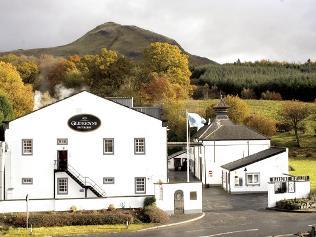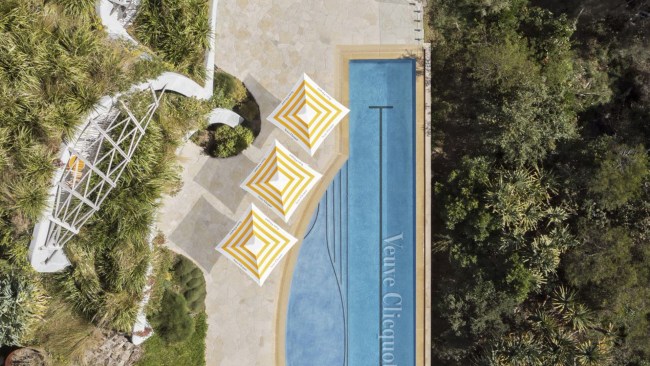Whisky galore
A VISIT to a Scottish Highlands distillery can bring out your inner master blender.

"I'LL give you a wee dram to get you going," says the small man, hunkered down in a big anorak loosely wrapped around a blue suit, as he leads me into a small office.
He's my guide for the morning as I undertake the so-called master blender session at Glengoyne distillery in a wooded valley in the southern Highlands of Scotland.
The lovely old building is close to a small river that flows into the famous Loch Lomond and a pleasurable and picturesque 30-minute drive from Glasgow. I've taken high roads and low roads to get here on this freezing morning; the sun, a watery yellow through the heavy mist, provides just enough light to see cows grazing on the hillsides.
My guide is Arthur MacFarlane, one of 16 on hand here; he's a master blender and a wonderfully loquacious companion on a damp Scottish morning. He projects the image of a mischievous schoolboy with a throaty chuckle and an expansive pixie-like grin. He looks up with a grimace as thunder sounds ominously above and lightning cracks a few volcanic hills away. "Well, it's good to dread the worst, as the old Scots saying goes," he beams. "For the best will be all the more welcome."
He hands me a 10-year-old Glengoyne, golden yellow in appearance, slightly sweet with a toffee aroma. "To clean your teeth," he says, with practised Scottish understatement.
Unlike most other single malts, he explains, Glengoyne has been preserving the essence of its flavour for decades by using barley that is dried by air rather than harsh peat smoke. The result is a more subtle, complex whisky in which all the delicate flavours are allowed to express themselves.
"Do you get the nutty, fresh green apples taste with that hint of sweet liquorice?" he asks. I nod, already feeling like a connoisseur, though I miss the linseed oil and almonds flavour when he adds some water. MacFarlane insists it's always good to add "a wee drop" to alter the taste of good malt. "But never drown it," he warns.
He pours us both another small measure, holding a glass up to the light. "Ah, a country in one glass," he purrs. "Did you know," he asks abruptly, "that the word whisky comes from uisge, a shortened form of uisge beatha, which means water of life in Scots Gaelic?"
Then, rarely stopping for breath, MacFarlane fills me in on the cultural anthropology of whisky making and the history of Glengoyne as we take a brief tour of the plant. Its name is taken from Glen Guin, or glen of the wild geese, and sits at the foot of a small waterfall tumbling from the volcanic plug of Dumgoyne Hill into the distillery grounds before continuing on to Loch Lomond.
"The water from the volcanic rock makes the whisky soft," he explains. "Like a printer putting down the background first." MacFarlane is amused that the Highland Line, which notionally divides Highland from Lowland Scotland, runs through the distillery grounds, making Glengoyne the southernmost single Highland malt. "The only whisky distilled in the Highlands and matured in the Lowlands," he says proudly.
MacFarlane leads me into the musty rooms of the distillery. The huge vats and copper piping are distinctly Victorian, the precinct of vaults and whitewashed spaces like something from a John Buchan novel, slightly gothic and preposterous. He shows me the entire process: where the barley is dried, ground into grist, mixed with the water off the ancient hill in vast tanks and passed into Oregon pine tubs as big as communal baths. There, with yeast added to convert malt sugars to alcohol, fermentation takes between 40 and 50 hours.
The spirit is distilled, nursed slowly through stills, eventually being allowed to mature in American and Spanish oak casks, some of which have been seasoned with sherry. He says the spirit sits there for 10 years, evaporating at 2 per cent in total. "Ah, we call that the angel's share," MacFarlane smiles as we enter a small high-ceilinged Victorian room, lined with lattice windows, like something out of a Conan Doyle novel.
This is the sample room, where the blending takes place, the pine benches and shelves filled with stoppered bottles and carefully printed white labels, beakers, test tubes, funnels and pipettes. A collection of glass containers is lined up in the centre of the long table representing spirit from the different whisky-producing regions of Scotland. Initially, it's as intimidating as the first day in high school chemistry but with much tasting and nosing of the different types of whisky, the fun takes over.
We play with peat-based whiskies and those with the whiff of apples, vanilla and pineapple, the colours varying from heavy treacle in the older varieties, to mahogany and sherry colours, all the way through to pale straw. MacFarlane, with the collection of different whiskies catalogued in his mind, is able to recall the age and provenance of each precious drop down to the location of the peat fires involved in their making. For him drinking Scotch whisky is more than indulgence: it is a tribute to the continuity of Scottish culture, a kind of manifesto of man's determination to use the resources of nature to refresh mind and body.
And he provides a wonderful and lateral insight into Scottish history along the way, with tales of smugglers and illicit stills in the days when the locals were unable to pay the heavy taxes imposed by the hated British government on spirit production to fund wars against France. Gradually, with MacFarlane's guidance, I add various spirits to a 100ml bottle; a personalised label will be attached.
He keeps offering wee drams through the process, which virtuously I decline as I have to drive back to Glasgow. But the many groups that attend each day can drink their tour fee's worth of fine malt if they choose.
I name my blend Stanger, after my Scottish grandfather, a reprobate whose family came from the Orkneys. After he suffered injuries at Gallipoli, he always drank his whisky with milk. I've never been a big one for the subtleties of drinking malt whiskies, usually finding the sniffing and muttering of connoisseurs a reason to roll my eyes and put it straight down the hatch.
Until I met MacFarlane I'd always agreed with the great television talk-show host Johnny Carson that when it comes to malt, "Happiness is having a rare steak, a bottle of whisky and a dog to eat the rare steak."
Now when I indulge, which is much more frequent, I savour the taste and colour, and I hear the old guide quoting James Joyce: "The light music of whisky falling into a glass. Oh, that's an agreeable interlude."
Graeme Blundell was a guest of Emirates, Visit Britain and Visit Scotland.
Checklist
The master blender session is £30 ($50) a person. More: www.glengoyne.com.
www.visitbritain.com.au
www.visitscotland.com
www.emirates.com/au



